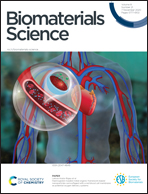A frog-derived bionic peptide with discriminative inhibition of tumors based on integrin αvβ3 identification†
Abstract
Aureins, natural active peptides extracted from skin secretions of Australian bell frogs, have become a research focus due to the antitumor effects caused by lysing cell membranes. However, clinical translation of Aureins is still limited by non-selective toxicity between normal and cancer cells. Herein, by structure–activity relationship analysis and rational linker design, a dual-function fusion peptide RA3 is designed by tactically fusing Aurein peptide A1 with strong anticancer activity, with a tri-peptide with integrin αvβ3-binding ability which was screened in our previous work. Rational design and selection of fusion linkers ensures α-helical conformation and active functions of this novel fusion peptide, inducing effective membrane rupture and selective apoptosis of cancer cells. The integrin binding and tumor recognition ability of the fusion peptide is further validated by fluorescence imaging in cell and mouse models, in comparison with the non-selective A1 peptide. Meanwhile, increased stability and superior therapeutic efficacy are achieved in vivo for the RA3 fusion peptide. Our study highlights that aided by computational simulation technologies, the biomimetic fusion RA3 peptide has been successfully designed, surmounting the poor tumor-selectivity of the natural defensive peptide, serving as a promising therapeutic agent for cancer treatment.



 Please wait while we load your content...
Please wait while we load your content...